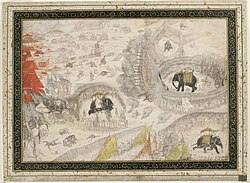Battle of Samugarh
| Battle of Samugarh | |||||||
|---|---|---|---|---|---|---|---|
| Part of Mughal war of succession (1658–1659) | |||||||
 Battle of Samugarh | |||||||
| |||||||
| Commanders and leaders | |||||||
|
Aurangzeb Murad Bakhsh (WIA) Bahadur Khan (WIA) Shaikh Mir Zulfiqar Khan Kilich Khan |
Dara Shikoh Sulaiman Shikoh Rao Chhatrasal Hada † Rustam Khan † | ||||||
| Strength | |||||||
| 50,000-60,000 men[1] | 50,000-60,000 men[1] | ||||||
Battle of Samugarh, Jang-e-Samugarh, (May 29, 1658), was a decisive battle in the struggle for the throne during the Mughal war of succession (1658–1659) between the sons of Mughal Emperor Shah Jahan after the emperor's serious illness in September 1657. The battle of Samugarh was the second battle fought between Dara Shikoh (the eldest son and heir apparent) and his three younger brothers Aurangzeb, Shah Shuja and Murad Baksh (third and fourth sons of Shah Jahan) to decide who would be the heir of the throne after their father.[2][3]
Background[edit]
Both sides had around 50,000 to 60,000 men however Aurangzeb was a much better general and his army was more experienced. Dara depended on his Hada Rajputs and Saiyids of Barha but the major bulk of his army was hastily recruited and had no experience in war. Dara was also overconfident and did not try to get help from the nobility of his father's empire.[1]
Battle[edit]
Dara Shukoh started the battle with cannonade, which continued for one hour. Dara's cavalry under Rustam then attacked Aurangzeb's artillery under Saif Shikan Khan, Rustam was soon attacked by Aurangzeb's infantry and both sides started cutting into each other. However, Dara's van continued to weaken as Rustam Khan died fighting and his men fled after his death. In Aurangzeb's army, Bahadur Khan was seriously wounded and fell from his horse, but Aurangzeb quickly sent reinforcements under Shaikh Mir to Bahadur's aid. The Rajputs of Dara, who formed the vanguard and right wing were able to penetrate into Auragzeb's van and attacked Zulfiqar and Murad. Murad was wounded in the fight and the left wing of Aurangzeb was completely routed by the Rajputs, who now attacked Aurangzeb's centre. However, Aurangzeb used his numbers to cut down the Rajputs and check their advance. Dara Shukoh, upon seeing the Rajputs fall, became indecisive and chose to dismount his elephant and retreat. According to Saqi Mustad Khan, Dara had control of his large reserves and Aurangzeb's army had grown tired. However, Dara, instead of reinforcing his van, chose to escape from the battlefield. Resulting in a decisive victory for Aurangzeb.[4][5]
Conclusion[edit]

Dara Shikoh’s army fled to Goindwal where Guru Har Rai had deployed his army, the Akal Sena, to prevent and delay Aurangzeb’s army from pursuing Dara Shikoh.[6]
After his victory, Aurangzeb would go on to imprison his brother Murād and father Shah Jahān, while Dara, escaped and tried to fight Aurangzeb again but was defeated and executed in 1659.[2]
See also[edit]
References[edit]
- ^ a b c Chandra, Satish (2005). Medieval India: From Sultanat to the Mughals Part - II. Har-Anand Publications. pp. 271–272. ISBN 9788124110669.
the sides being almost equally matched in numbers (about 50,000 to 60,000 on each side)...The Hada Rajputs and Saiyads of Barha upon whom Dara largely depended could not make up for the weakness of the rest of the hastily recruited army.
- ^ a b "Battle of Samugarh | Mughal history | Encyclopædia Britannica". britannica.com. Retrieved 2015-02-22.
- ^ Baig, Murad Ali. "Not Plassey 1757 but Samugarh 1658: Fateful tipping point that fixed the subcontinent's future course". The Times of India.
- ^ Roy, Kaushik (3 June 2015). Warfare in Pre-British India - 1500BCE to 1740CE. Routledge. p. 139. ISBN 9781317586920.
In the close quarter combat...Bahadur Khan fell...the Rajput troopers from Dara's vanguard and his right wing penetrated between Zulfiqar Khan...Murad was wounded...and after defeating Aurangzebs left wing the rajputs turned towards Aurangzeb's centre...the outnumbered rajputs were finally checked by Aurangzeb's centre...Dara had a large reserve, but instead of feeding the reserve into the battle...Aurangzebs force was exhausted....Dara lost heart...he dismounted from his elephant and escaped.
- ^ Lal, M. (1988). Aurangzeb. Vikas Pub. House. Retrieved 2015-02-22.
- ^ Takhar, Opinderjit Opinderjit; Jakobsh, Doris R. (2023). Global Sikhs: Histories, Practices and Identities. Routledge Critical Sikh Studies. Taylor & Francis. ISBN 9781000847352.
During the time of the seventh Guru, the emphasis on armed conflict with the Mughals receded, but Guru Har Rai held court and kept a regular force of Sikh horsemen. He had favorable relations with Dara Shikoh (eldest son of Emperor Shah Jahan and heir apparent to the Mughal throne), who sought the Guru's help while he was fleeing in front of the army of his younger brother Aurangzeb, after his defeat in the battle of Samugrah on May 29, 1658. According to Mahimà Prakäsh Värtak, Guru Har Rai deployed his own troops at the ferry at Goindval to delay Aurangzeb's army, which was pursuing Dara Shikoh at his heels
